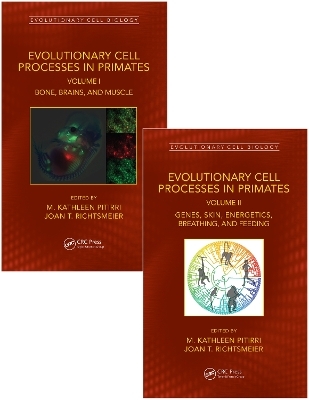
Evolutionary Cell Processes in Primates
CRC Press
978-1-032-07355-2 (ISBN)
- Titel z.Zt. nicht lieferbar
- Versandkostenfrei innerhalb Deutschlands
- Auch auf Rechnung
- Verfügbarkeit in der Filiale vor Ort prüfen
- Artikel merken
Key Features
Explores the developmental basis of characteristics that define the primate lineage
Documents cellular mechanisms associated with everything from skin and eneregetics to the brain and communication.
Chapters by a team of leading international researchers
M. Kathleen Pitirri, PhD is a Postdoctoral Scholar in the Department of Anthropology at Pennsylvania State University. She received her PhD from the University of Toronto in 2019 where she studied primate evolution, focusing specifically on the taxonomic, ontogenetic, and functional basis of mandibular shape variation in living and fossil primates. During her PhD research, Dr. Pitirri developed a novel methodology for studying shape variation of mandibular fragments that are part of the primate fossil record. She found a strong relationship between the shape of the mandibular corpus and molar crypt formation in great apes, suggesting that mandibular shape is linked to an extended period of development in great apes, representing an important evolutionary shift in primates. Upon joining the Richtsmeier Lab, Dr. Pitirri began using mouse models to study the cellular mechanisms involved in transferring information from the genotype to the phenotype. The changes observed in mouse models can be used to interpret the cellular basis for changes observed in skull shape in primates because mechanisms that build the craniofacial skeleton during development also drive variation in disease and evolution. Dr. Pitirri is particularly interested in the evolutionary consequences of change in developmental processes driving the patterning of cellular activities involved in embryogenesis of skull bones, the role of the chondrocranium in skull development, and the genetic pathways regulating the relationship between tooth and bone formation during embryonic development. Joan Richtsmeier is Distinguished Professor of Anthropology at the Pennsylvania State University. She received her PhD from Northwestern University in 1985 and joined the faculty of the Department of Cell Biology and Anatomy, Johns Hopkins University School of Medicine in 1986. There, she focused on establishing new quantitative methods for studying change in biological shape through time, especially in primates, with Professor Subhash Lele. In 1999 she became the 55th woman to achieve the rank of Professor at Johns Hopkins University School of Medicine since the school opened in 1893. In 2000, Dr. Richtsmeier moved her lab to the Pennsylvania State University. There, her focus turned to joining developmental biology with evolutionary biology, and with collaborators and students, she has worked to integrate the study of mouse models carrying known genetic variants with understanding the biological basis of patterns of evolutionary change. She is particularly interested in early formation of the chondrocranium and how and why cells decide to become osteoblasts and make bone. Dr. Richtsmeier was elected Fellow of the American Association of Anatomists (AAA) in 2018, received the Henry Gray Scientific Achievement Award of the AAA in 2019, and the David Bixler Excellence in Craniofacial Research Award of the Society for Craniofacial Genetics and Developmental Biology in 2019. She was elected Fellow of the AAAS (Section on Biological Sciences) in 2020. Her work is supported by grants from the National Science Foundation, the National Institutes of Health, and the Wellcome Trust.
Volume 1
Introduction - Why are we looking at cells (and why aren’t we focusing on genes)?. Locomotion. Bipedalism - Developmental mechanisms of hindlimb elongation. Evolution of leaping and jumping. Bipedalism - Artificial selection for increased running in mice, plasticity and limb shape, what changes? Hands and Feet - how does a pisiform make a difference? Axial Skeleton/Tail length. Visual cortex development and locomotion in primates. Stereoscopic 3D vision. Evolution and development of the shoulder. Energetics. Biology of human-environment interactions. Brown adipose tissue in human evolution. Evolution of color vision in primates (opsin genes). Craniofacial morphology and thermoregulation or short limbs (dwarfism). Diet. Taste bud development and evolution of primate diets. Mandibular function. Primate dental evolution. Jaw bone and tooth development and evolution. Hair Loss, Skin, Nails. Evolution and development of nails in primates. Human evolution of sweat glands and hair loss. Hair and fur: cell biology of tissue polarity and epithelial patterning. Hair and skin pigmentation in human evolution. Development of skin in human evolution.
Volume 2
Introduction. Encephalization. Expensive tissue hypothesis revisited. Human cognition. Stem cells in cranial sutures. Chondrocytes becoming osteoblasts or Neural crest cells and forebrain morphogenesis. Craniofacial development in primates. Determinants of brain size. Developmental basis of evolutionary trend in primate encephalization. How cells make brains. Tool Making. Digit evolution. Evolution of carpals in primates. Molecular development of the thumb in primates. Neural basis for tool-making. Breathing, smelling, spoken language. Olfaction versus respiration in primates. Nasal architecture. Vocal tract. Evolution of larynx and language. Evolutionary neuroscience of language. Aging, life history, growth patterns. Life history in non-human primates: what would it take at the cellular level? Life History – Developmental changes in quadrupedal and leaping primates. Evolution and embryonic development. Life history and growth patterns. Evolution of aging. Integration of the skull during growth and development and evolution.
| Erscheint lt. Verlag | 29.9.2021 |
|---|---|
| Reihe/Serie | Evolutionary Cell Biology |
| Zusatzinfo | 13 Tables, black and white; 19 Line drawings, color; 21 Line drawings, black and white; 24 Halftones, color; 3 Halftones, black and white; 43 Illustrations, color; 24 Illustrations, black and white |
| Verlagsort | London |
| Sprache | englisch |
| Maße | 156 x 234 mm |
| Gewicht | 1152 g |
| Themenwelt | Naturwissenschaften ► Biologie ► Genetik / Molekularbiologie |
| Naturwissenschaften ► Biologie ► Humanbiologie | |
| Naturwissenschaften ► Biologie ► Zellbiologie | |
| ISBN-10 | 1-032-07355-1 / 1032073551 |
| ISBN-13 | 978-1-032-07355-2 / 9781032073552 |
| Zustand | Neuware |
| Informationen gemäß Produktsicherheitsverordnung (GPSR) | |
| Haben Sie eine Frage zum Produkt? |
aus dem Bereich


